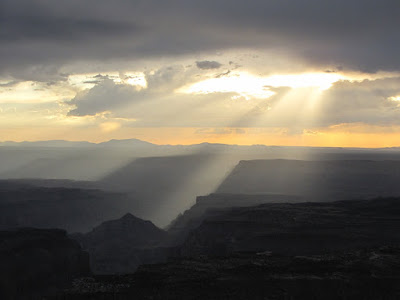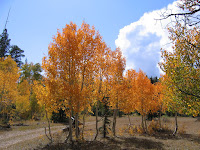
Mountain Lying Down. That's the rough translation of the word Kaibab from Paiute to English, and it accurately describes this lofty but relatively flat landform north of the Grand Canyon. Despite it's apparent lack of rugged topography however, the Grand Canyon would not be as spectacular without the Kaibab. The Colorado River cuts deeply into the surrounding landscape, but where the Canyon achieves it's full height and glory is the area where the Kaibab rises up over 9000 feet above sea level, making for the one of the world's largest and deepest canyon systems.

The plateau rises sharply from the surrounding terrain, and is an oasis of trees and plants not commonly found in Arizona. Aspen, spruce, fir, and ponderosa grow in profusion here, and large open meadows create a feeling of spaciousness. Because of the elevation, the Kaibab receives significant snowfall during the winter months, resulting in the closure of the North Rim from mid-October to mid-May. In the summer daily thunderstorms are common, and the usually abundant moisture allows for plants and animals to thrive here above an otherwise dry and arid land.
The majority of the plateau is managed by the Forest Service as the Kaibab National Forest, except for the southern edge where the North Rim of Grand Canyon National Park is located. Like most public lands, the Kaibab is managed under the "multiple use" doctrine, and logging and cattle grazing take place over the entire area.

Even so, the region feels relatively unspoiled, largely because so few people ever actually spend any time off the single highway that bisects the plateau. It also helps that the Kaibab is far from any major metropolitan area, although in recent years it has gained renown among hunters as one of the best Mule Deer trophy hunts in the west.
The general orientation of the plateau is north/south, with the southern end looking out over Grand Canyon proper. To the east, the Kaibab towers over House Rock Valley and Marble Canyon, and west offers longitudinal views along the mostly unseen parts of Grand Canyon. North the plateau gradually descends in elevation becoming Buckskin Mountain, with Fredonia/Kanab to the west, and the Paria Plateau rising to the east.
The Warm Fire
In June 2006 a dry lightning strike started a fire on the Kaibab Plateau. At the time the Forest Service elected to allow the fire to burn as part of the Wildland Fire Use directive; that is to reestablish a natural fire regime in the forest. For just over 2 weeks the fire burned at a relatively low intensity, clearing overgrown and down and dead material from the forest.
 |  |
On June 25th, the winds shifted and became stronger, and pushed the fire into steep and heavily wooded ravines outside the management area. Within 24 hours the fire was out of control, raging unchecked through dense stands of mature trees. By the time the fire was contained on July 4th, over 58,000 acres had burned, some of it severely. Highway 67 travels for several miles through some of the most heavily damaged sections, and it is a sobering look at the dangers of wildfire. Fortunately there is encouraging evidence that eventually these scars will heal, as new aspen shoots are beginning to appear in even the most devastated areas.
East
Several roads lead to the eastern edge of the plateau, offering sweeping views of House Rock Valley, where Marble Canyon cuts it's way south towards the Grand Canyon. The two best known are Marble View and the East Rim Viewpoint. On a clear day the vista extends to the Kaiparowits, looming over the Vermilion Cliffs to the north. On the eastern edge, the Echo Cliffs mark the edge of White Mesa.

Far below the high desert shimmers in the heat, and the uniformly brown and red landscape speaks of the aridity of the land. The occasional summer thunderstorm drops heavy rain in localized areas, evidenced by the floodplain where braided channels are seen carved in easily eroded soils. Despite the austerity, the rugged beauty is a delight to behold - especially from the cool fastness of the forest.
 |  |
West
The western edge of the plateau forms the boundary of Grand Canyon National Park. From the rim below all the splendor that is the Canyon is visible. What makes it even better is that the land on the rim is part of the National Forest, and few of the restrictions in place in the Park apply here. While the scenery is only ever so slightly less spectacular overlooking the western end of the Canyon, the fact that in many places you can camp on or very near the rim more than makes up for any diminishment.
 |  |  |


 There are a number of viewpoints to choose from. To the north is Parissawampitts Point, then to the south comes Fence, Locust, North Timp, Timp, and finally Fire Point. All offer slightly different angles to a part of the Canyon few visitors ever see. An added bonus is the western horizon - sunsets here are usually nothing less than spectacular.
There are a number of viewpoints to choose from. To the north is Parissawampitts Point, then to the south comes Fence, Locust, North Timp, Timp, and finally Fire Point. All offer slightly different angles to a part of the Canyon few visitors ever see. An added bonus is the western horizon - sunsets here are usually nothing less than spectacular.


Fall on the Kaibab
 I enjoy visiting the Kaibab whenever I can, but autumn is by far my favorite time. Days are cool, with cold clear nights. The air has that distinct crispness to it that signals the inevitable onset of winter. The aspen trees begin their annual transformation to blazing gold, orange, yellow, and in some cases red. It is a melancholy and reflective time for me in some ways, as I contemplate the close of summer and the end of the freedom I am blessed with during the warmer months.
I enjoy visiting the Kaibab whenever I can, but autumn is by far my favorite time. Days are cool, with cold clear nights. The air has that distinct crispness to it that signals the inevitable onset of winter. The aspen trees begin their annual transformation to blazing gold, orange, yellow, and in some cases red. It is a melancholy and reflective time for me in some ways, as I contemplate the close of summer and the end of the freedom I am blessed with during the warmer months.While fall colors in the Mountain West are but pale imitations of those found back east and in the north, they are still undeniably beautiful. The dark mass of sub-alpine trees provides a somber contrast for the vivid and almost fluorescent colors of the aspens trees, and when gentle breezes of brisk fall air stir the leaves into a gentle whisper, I am as content with the world as a person has any right to be.



 |  |

No comments:
Post a Comment